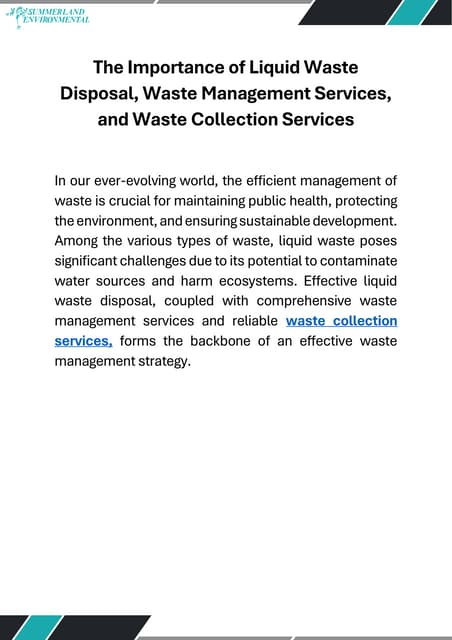Reclaim Waste Fundamentals Explained
Little Known Facts About Reclaim Waste.
Table of ContentsReclaim Waste Fundamentals ExplainedUnknown Facts About Reclaim WasteRumored Buzz on Reclaim WasteThe Basic Principles Of Reclaim Waste Some Known Details About Reclaim Waste
Domestic sewer waste refers to the waste and items from a property septic container. The proper monitoring and disposal of domestic sewage waste need fluid waste to be moved to a sewer therapy plant where the appropriate methods and tools are applied to cleanse and dispose of waste.
Commercial waste commonly consists of possible threats, such as combustible materials or a mixture of fluid and strong waste products, and calls for an extra sophisticated and thorough disposal process. The disposal of commercial waste usually entails the filtering of waste prior to transportation to guarantee risk-free and appropriate disposal. Industrial waste is developed from results and drainage of commercial procedures and manufacturing.
This type of waste can not make use of the very same sewage administration transportation or processes as septic or business liquids. The hazardous waste administration procedure calls for the inspection and screening of fluid waste prior to it undergoes the disposal process (liquid waste removal melbourne). Drainage waste is the liquid waste that comes from runoff and excess stormwater in highly inhabited locations or cities
Drainage waste can cause contamination and flooding if not dealt with properly. Find out more about drain cleaning and waste monitoring. Ensuring appropriate waste monitoring can protect against calamities and lower ecological harm. Both individuals in property settings and professionals in commercial or production sectors can gain from understanding the processes and policies of fluid waste monitoring.
Reclaim Waste Fundamentals Explained
Get in touch with PROS Services today to learn more about our waste management and disposal services and the appropriate ways to look after the liquid waste you generate.
(https://www.huntingnet.com/forum/members/reclaimwaste1.html)Do you recognize what occurs to your water when you pull the plug, flush the commode or drain pipes the cleaning maker? No? Well, it's worth recognizing. This supposed 'wastewater' is not only an important resource however, after therapy, will be launched to our land, waterways or the sea. Made use of water from bathrooms, showers, baths, kitchen sinks, washings and industrial procedures is understood as wastewater.

water utilized to cool machinery or clean plant and devices). Stormwater, a form of wastewater, is overflow that flows from farming and urban locations such as roofings, parks, yards, roadways, paths and gutters right into stormwater drains, after rainfall. Stormwater moves untreated straight to local creeks or rivers, ultimately getting to the ocean.
How Reclaim Waste can Save You Time, Stress, and Money.
In Queensland, most wastewater is treated at sewage treatment plants. Wastewater is moved from domestic or industrial websites via a system of sewers and pump stations, known as sewage reticulation, to a sewer therapy plant.
The Division of Natural Resources suggests neighborhood governments regarding handling, operating and preserving sewerage systems and therapy plants. In unsewered areas, regional governments may call for householders to mount private go or family sewage treatment systems to treat residential wastewater from toilets, cooking areas, washrooms and washings. The Division of Natural Resources authorizes making use of home systems when they are confirmed to be effective.
The majority of stormwater obtains no treatment. In some new subdivisions, therapy of some stormwater to eliminate litter, sand and crushed rock has actually begun making use of gross contaminant traps. Wastewater therapy occurs in 4 stages: Removes solid matter. Bigger solids, such as plastics and other things mistakenly discharged to sewage systems, are gotten rid of when wastewater is passed through displays.
Wastewater after that flows right into large containers where solids work out and are gotten rid of as sludge. Grease and residue are skimmed from the surface. Utilizes small living organisms referred to as micro-organisms to break down and eliminate continuing to be dissolved wastes and great particles. Micro-organisms and wastes are incorporated in the sludge. Removes nitrogen and phosphorus nutrients that might create algal blossoms in our waterways and intimidate aquatic life.
The Basic Principles Of Reclaim Waste
Nutrient removal is not offered at all sewage treatment plants since it calls for expensive specialised equipment. It is becoming extra usual in Queensland. Clear fluid effluent generated after therapy might still have disease-causing micro-organisms. If this effluent is launched right into rivers such as rivers or the sea, the micro-organisms will ultimately pass away out.

This typically implies wastewater has to be treated or pollutants eliminated before it can be discharged to waterways. The majority of wastewater streams into the sewage system. Under the Act, local federal governments administer approvals and licences for ecologically appropriate tasks (ERAs) including wastewater launches that may have a neighborhood impact. The department carries out authorizations and licences to ERAs entailing wastewater launches that may have a regional or statewide effect.
Getting My Reclaim Waste To Work
Otherwise, samples are considered laboratory evaluation. Usually lots of examinations are needed to establish the levels of each of the various pollutants such as oils, heavy metals and chemicals in water. Monitoring offers valid details about water high quality and can validate that permit problems are being met. The information acquired through monitoring gives the basis for making water quality choices.